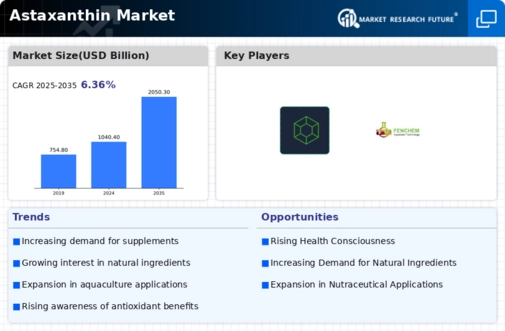Top Industry Leaders in the Astaxanthin Market

The Astaxanthin market is marked by intense competition among key players who strive to capture a share of the growing demand for this natural antioxidant. As consumer awareness regarding the health benefits of astaxanthin increases, companies are deploying various strategies to strengthen their market positions. Key players, such as Cyanotech Corporation, Fuji Chemical Industry Co., Ltd., and Algatech Ltd., dominate the industry, while new and emerging companies contribute to the competitive landscape by introducing innovative products and technologies.
Key Players:
Cardax Inc. (US)
BASF SE (Germany)
Alga Technologies (Israel)
Archer-Daniels-Midland Company (US)
Koninklijke DSM NV (Netherlands)
Cyanotech Corporation (US)
Beijing Gingko Group (China)
Fuji Chemical Industries Co. Ltd (Japan)
Fenchem (China)
Otsuka Holdings Co.Ltd (Japan).
Strategies Adopted:
Key players in the Astaxanthin market implement strategies to maintain and enhance their competitive positions. Research and development efforts focus on improving astaxanthin extraction methods, ensuring higher purity and bioavailability. Strategic partnerships with distributors and retailers help expand market reach, making astaxanthin products more accessible to a broader consumer base. Companies also invest in marketing initiatives to educate consumers about the health benefits of astaxanthin, emphasizing its antioxidant properties and potential applications in various sectors.
Market Share Analysis:
Market share analysis in the Astaxanthin market is influenced by factors such as product quality, brand reputation, distribution network, and regulatory compliance. Companies with a history of producing high-quality astaxanthin from natural sources tend to command larger market shares. Effective distribution channels and strong partnerships with retailers contribute to increased market presence. Compliance with industry standards and regulations is crucial for building trust among consumers, influencing their purchasing decisions.
New & Emerging Companies:
New and emerging companies in the Astaxanthin market play a vital role in fostering innovation and competition. These companies often focus on niche segments, introducing unique formulations and applications for astaxanthin. Their agility allows them to explore novel extraction technologies and cultivation methods, contributing to the diversification of products available in the market. While these companies may initially have smaller market shares, their innovative approaches add dynamism to the industry.
Industry Trends:
Recent industry news in the Astaxanthin market indicates a growing trend toward sustainability and environmentally friendly practices. Key players are investing in technologies that enhance the efficiency of astaxanthin production, reducing the environmental footprint. Additionally, investments are directed towards expanding cultivation facilities to meet the increasing demand for astaxanthin across various end-use industries.
Competitive Scenario:
The overall competitive scenario in the Astaxanthin market is dynamic, with companies adapting to the evolving needs of consumers and industries. Collaboration with research institutions and participation in industry conferences contribute to staying informed about the latest developments and market trends. Companies are also exploring new applications for astaxanthin, such as its use in animal feed and aquaculture, to tap into emerging opportunities and broaden their revenue streams.
Recent Development
A notable development in 2023 within the Astaxanthin market is the increased focus on applications in the beauty and skincare industry. Key players are leveraging the antioxidant and anti-inflammatory properties of astaxanthin to formulate skincare products that address concerns such as aging and UV-induced skin damage. This development aligns with the growing trend of consumers seeking natural and sustainable ingredients in their personal care products.


